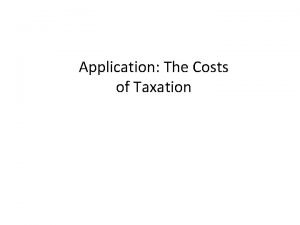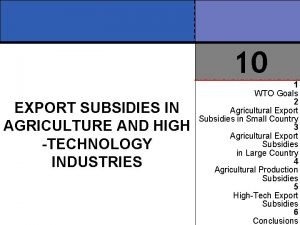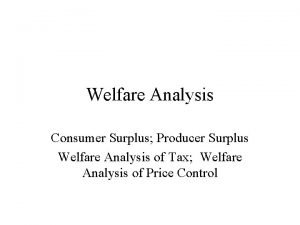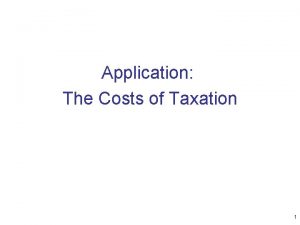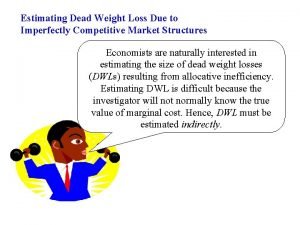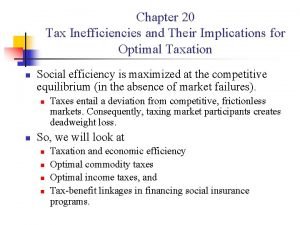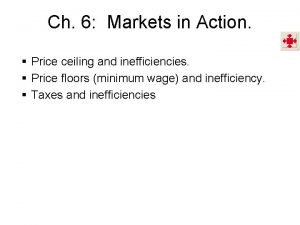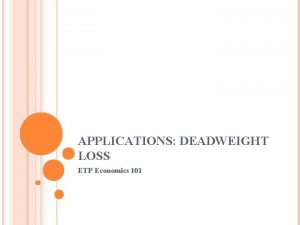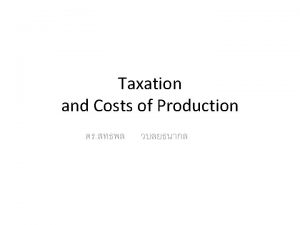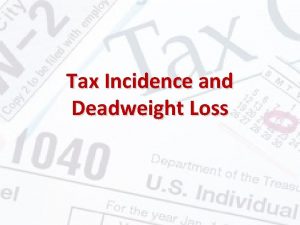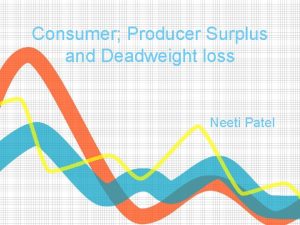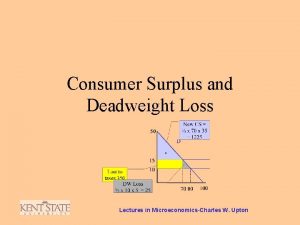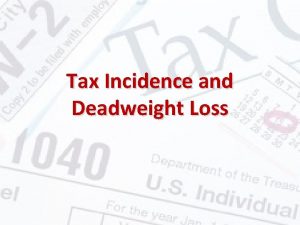Application The Costs of Taxation 1 Deadweight Loss
















- Slides: 16

Application: The Costs of Taxation 1

Deadweight Loss of Taxation • Tax on a good levied on buyers – Demand curve shifts leftward • By the size of tax • Tax on a good levied on sellers – Supply curve shifts leftward • By the size of tax 2

Deadweight Loss of Taxation • Tax on a good levied on buyers or on sellers – Same outcome: a price wedge – Price paid by buyers – rises – Price received by sellers – falls – Lower quantity sold 3

Deadweight Loss of Taxation • Tax burden – Distributed between producers and consumers – Determined by elasticities of supply and demand • Market for the good – Smaller 4

The Effects of a Tax Price Supply Price buyers pay Size of tax Price without tax Price sellers receive Demand 0 Quantity with tax Quantity without tax Quantity A tax on a good places a wedge between the price that buyers pay and the price that sellers receive. The quantity of the good sold falls. 5

Deadweight Loss of Taxation • Gains and losses from a tax on a good – Buyers: consumer surplus – Sellers: producer surplus – Government: total tax revenue • Tax times quantity sold • Public benefit from the tax 6

Tax Revenue Price Size of tax (T) Price buyers pay Supply Tax revenue TˣQ Price sellers receive Quantity sold (Q) 0 Quantity with tax Quantity without tax Demand Quantity 7

How a Tax Affects Welfare Price buyers pay =PB Supply A B Price without =P 1 tax D Price =PS sellers receive F Demand 0 Q 2 Q 1 Quantity 8

Deadweight Loss of Taxation • Deadweight losses and gains from trade – Taxes cause deadweight losses • Prevent buyers and sellers from realizing some of the gains from trade – The gains from trade • Difference between buyers’ value and sellers’ cost are less than the tax • Once the tax is imposed – Trades are not made – Deadweight loss 9

The Deadweight Loss Price Lost gains from trade PB Supply Size of tax Price without tax PS Cost to Demand sellers Value to buyers 0 Q 2 Q 1 Quantity Reduction in quantity due to the tax 10

Determinants of Deadweight Loss • Price elasticities of supply and demand – More elastic supply curve • Larger deadweight loss – More elastic demand curve • Larger deadweight loss • The greater the elasticities of supply and demand – The greater the deadweight loss of a tax 11

Tax Distortions and Elasticities (a, b) (a) Inelastic Supply (b) Elastic Supply When supply is relatively inelastic, the deadweight loss of a tax is small Price When supply is relatively elastic, the deadweight loss of a tax is large Price Supply Size of tax 0 Size of tax Demand Quantity Demand 0 Quantity 12

Tax Distortions and Elasticities (c, d) (c) Inelastic Demand When demand is relatively inelastic, the deadweight loss of a tax is small Price (d) Elastic Demand Price Supply Size of tax When demand is relatively elastic, the deadweight loss of a tax is large Supply Size of tax Demand 0 Quantity 13

The deadweight loss debate • How big should the government be? – The larger the deadweight loss of taxation • The larger the cost of any government program – If taxes impose large deadweight losses • These losses - strong argument for a leaner government – Does less and taxes less – If taxes impose small deadweight losses • Government programs - less costly 14

How Deadweight Loss and Tax Revenue Vary with the Size of a Tax (a, b, c) (b) Medium tax Price Deadweight loss Supply PB PS Price Deadweight loss Supply PB Tax revenue (c) Large tax Deadweight loss PB Tax revenue Demand PS Supply Tax revenue (a) Small tax Demand PS 0 Q 2 Q 1 Quantity 15

How Deadweight Loss and Tax Revenue Vary with the Size of a Tax (d, e) (d) From panel (a) to panel (c), deadweight loss continually increases Deadweight loss (e) From panel (a) to panel (c), tax revenue first increases, then decreases Tax Revenue Laffer curve 0 Tax size Panels (d) and (e) summarize these conclusions. Panel (d) shows that as the size of a tax grows larger, the deadweight loss grows larger. Panel (e) shows that tax revenue first rises and then falls. This relationship is sometimes called the Laffer curve. 16
 Tax revenue and deadweight loss graph
Tax revenue and deadweight loss graph Positive externality deadweight loss
Positive externality deadweight loss Deadweight loss in monopoly
Deadweight loss in monopoly Subsidy deadweight loss
Subsidy deadweight loss Is there deadweight loss in a monopoly
Is there deadweight loss in a monopoly Producer
Producer Deadweight loss tax
Deadweight loss tax Positive externality deadweight loss
Positive externality deadweight loss How to calculate deadweight loss
How to calculate deadweight loss Dead weight loss formula
Dead weight loss formula Monopoly deadweight loss
Monopoly deadweight loss Deadweight loss of tariff
Deadweight loss of tariff Allocative efficiency in monopoly
Allocative efficiency in monopoly Price ceiling and deadweight loss
Price ceiling and deadweight loss 2222012
2222012 Is there deadweight loss in a monopoly
Is there deadweight loss in a monopoly Health externalities
Health externalities
